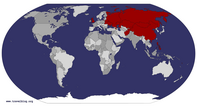Pre-Travelblog Travels (Oman, Argentina, the Amazon, West Papua, Indonesia, Russia)
September 8th 1983 -» July 1st 2008
Armenia
July 6th 2008 -» July 26th 2008
Arctic Russia
July 27th 2008 -» August 10th 2008
Vanuatu
August 13th 2008 -» September 22nd 2008
Micronesia
September 23rd 2008 -» October 5th 2008
The Philippines
October 8th 2008 -» April 2nd 2009
China
April 3rd 2009 -» April 30th 2009
Mongolia
May 3rd 2009 -» May 21st 2009
England
May 28th 2009 -» August 1st 2009
Former USSR (part 1)
August 2nd 2009 -» July 19th 2010
Central Asia and Afghanistan
July 20th 2010 -» September 26th 2010
Former USSR (part 2)
September 27th 2010 -» ongoing






































